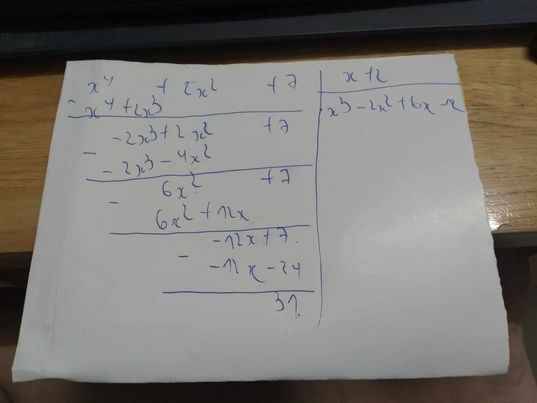Hãy nhập câu hỏi của bạn vào đây, nếu là tài khoản VIP, bạn sẽ được ưu tiên trả lời.

a) Ta có : (3x - 0.5) ( 2x + 2.5) = 0
\(\Leftrightarrow\orbr{\begin{cases}3x-0,5=0\\2x+2,5=0\end{cases}}\)
\(\Leftrightarrow\orbr{\begin{cases}3x=0,5\\2x=-2,5\end{cases}}\)
\(\Leftrightarrow\orbr{\begin{cases}x=\frac{0,5}{3}=\frac{1}{6}\\x=-\frac{2,5}{2}=\frac{5}{4}\end{cases}}\)

\(P\left(x\right)+Q\left(x\right)=x^3-2x+1+2x^2-2x^3+x-5=-x^3+2x^2-x-4\)
\(P\left(x\right)-Q\left(x\right)=x^3-2x+1-2x^2+2x^3-x+5=3x^3-2x^2-3x+6\)
Tick mình nha bạn. Chúc bạn một năm mới vui vẻ ,hạnh phúc, may mắn, học giỏi...

a,f(1/2)=5-2*(1/2)=5-1=4
f(3)=5-2x3=5-6=-1
b,Với y=5 thì 5-2x=5
2x=5-5
2x=0
x=0:2=0
Vậy x=0
Với y=-1 thì 5-2x=-1
2x=5-(-1)
2x=5+1
2x=6
x=6:2=3
Vậy x=3

Cho 2 đa thức: f(x)= 9 - x5 + 4x - 2x3 + x2 - 7x4
g(x)= x5 - 9 + 2x2 + 7x4 + 2x3 - 3x
a) Sắp sếp các đa thức trên theo luỹ thừa giảm dần của biến
f(x)= 9 - x5 + 4x - 2x3 + x2 - 7x4
f(x) = -x5 - 7x4 - 2x3 + x2 + 4x + 9
g(x)= x5 - 9 + 2x2 + 7x4 + 2x3 - 3x
g(x) = x5 + 7x4 + 2x3 + 2x2 - 3x - 9
b) Tìm bậc, hệ số cao nhất, hệ số tự do của đa thức f(x); g(x)
f(x) = -x5 - 7x4 - 2x3 + x2 + 4x + 9
+ Bậc : 5 _ hệ số cao nhất : -1 _ hệ số tự do : 9
g(x) = x5 + 7x4 + 2x3 + 2x2 - 3x - 9
+ Bậc : 5_ hệ số cao nhất : 1 _ hệ số tự do : -9
c) Tính f(x) + g(x); f(x) - g(x)
f( x) + g(x) = ( -x5 - 7x4 - 2x3 + x2 + 4x + 9 ) +( x5 + 7x4 + 2x3 + 2x2 - 3x - 9 )
= -x5 - 7x4 - 2x3 + x2 + 4x + 9 + x5 + 7x4 + 2x3 + 2x2 - 3x - 9
= ( -x5 + x5 ) + ( -7x4 + 7x4 ) + ( -2x3 + 2x3 ) + ( x2 + 2x2 ) + ( 4x -3x ) + ( 9 - 9 )
= 3x2 + x
f( x) - g(x) = ( -x5 - 7x4 - 2x3 + x2 + 4x + 9 ) - ( x5 + 7x4 + 2x3 + 2x2 - 3x - 9 )
= -x5 - 7x4 - 2x3 + x2 + 4x + 9 - x5 - 7x4 - 2x3 - 2x2 + 3x + 9
= ( -x5 - x5 ) + ( -7x4 - 7x4 ) + ( -2x3 - 2x3 ) + ( x2 - 2x2 ) + ( 4x + 3x ) + ( 9 + 9 )
= -2x5 - 14x4 - 2x3 -x2 + 7x + 18

A + B = (2x^2 y^2 - 4x^3 + 7xy - 18) + (x^3y + x^2y^2 - 15xy + 1)
= 2x^2 y^2 - 4x^3 + 7xy - 18 + x^3y + x^2y^2- 15xy + 1
= (2x^2 y2 + x^2y^2) - 4x^3 + x^3y + (7xy – 15xy) + ( -18 + 1)
= 3x^2 y2 - 4x^3 + x^3y – 8xy – 17

a) Thay f(1/2) vào hàm số ta có :
y=f(1/2)=5-2.(1/2)=4
Thay f(3) vào hàm số ta có :
y=f(3)=5-2.3=-1
b) y=5-2x <=> 5-2x=5
2x=5-5
2x=0
=> x=0
<=> 5-2x=-1
2x=5-(-1)
2x=6
=> x=3
a, f (1/2) = 5 - 2.1/2 = 4
f (3) = 5 - 2.3 = -1
b, y = 5 <=> 5 - 2x = 5
<=> x = 0
y = -1 <=> 5 - 2x = -1
<=> x = 3
_Hok tốt_
( sai thì thôi nha )

2.(x-1)-3.(2x+2)-4.(2x+3)=16
=>2x-2-6x-6-8x-12=16
=>2x-6x-8x-(2+6+12)=16
=>x.(2-6-8)=16+20=36
=>x.(-12)=36
=>x=-3
Vậy x=-3
\(2\left(x-1\right)-3\left(2x+2\right)-4\left(2x+3\right)=16\)
\(\Leftrightarrow2x-2-6x-6-8x-12=16\)
\(\Leftrightarrow\left(2x-6x-8x\right)+\left(-2-6-12\right)=16\)
\(\Leftrightarrow-12x-20=16\)
\(\Leftrightarrow-12x=36\)
\(\Leftrightarrow x=\frac{-36}{12}-3\)
a) ĐKXĐ: $x\ne-2$
\(\dfrac{x^4+2x^2+7}{x+2}=\dfrac{x^4+2x^3-2x^3-4x^2+6x^2+12x-12x-24+31}{x+2}\)
\(=\dfrac{x^3\left(x+2\right)-2x^2\left(x+2\right)+6x\left(x+2\right)-12\left(x+2\right)+31}{x+2}\)
\(=\dfrac{\left(x^3-2x^2+6x-12\right)\left(x+2\right)+31}{x+2}\)
\(=x^3-2x^2+6x-12+\dfrac{31}{x+2}\)
b) Đặt \(f\left(x\right)=x^2+10x+a\). Khi đó, vì \(f(x)\vdots(x+3)\) nên theo định lí Bezóut, ta được: \(f\left(-3\right)=0\)
\(\Leftrightarrow\left(-3\right)^2+10\cdot\left(-3\right)+a=0\)
\(\Leftrightarrow-21+a=0\Leftrightarrow a=21\)
b: \(x^2+10x+a⋮x+3\)
=>\(x^2+3x+7x+21+a-21⋮x+3\)
=>a-21=0
=>a=21
a: